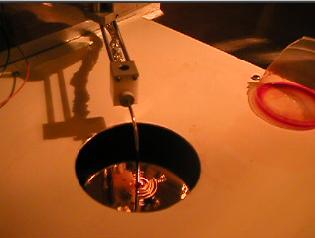The best known method to put a 2 um thck
layer of a polymer on to a round surace is to spin coat it. The UV
sensitive photoresist is made of polymeres wich is dissolved in
an organic solvent. When the solvent are dried the residue, the
photosensitive polymere, are left as a smooth thin dry layer. By
pouring the liquid at the center of a fast rotating
substrate the centrifugal force will create a high
quality layer. Still today this manuacturing method is the choice
for almost all silicon wafer productions. Square substrates wich
can´t be rotated fast, other methods can be used.
A tremendous problem was the handling of more then 20 different sizes in the production plant. Also handling of thin 0,1mm glass substrates made automation very tricky. A simple solution was manually deposition of each substrate.

An operator manually spin coat substrates. After this is done post
baking is done on a heat plate to remove the residue of solvents.
A nice photoresist were used, shipley S1818, This is a standard all purpose type for g, h and i line exposure.
Data of the photoresist (pdf-file)
Some efforts were made to automate the deposition and a PLC controlled system for the deposition was developed. It worked at some level but photoresist is a very tricky liquid and very small amount of impurities makes the distribution of the liquid very tricky. This issues were never fully solved.
Short film from the operation of the photoresist robot. Appr 7Mbyte.

A photoresist robot were tested.
A tremendous problem was the handling of more then 20 different sizes in the production plant. Also handling of thin 0,1mm glass substrates made automation very tricky. A simple solution was manually deposition of each substrate.

An operator manually spin coat substrates. After this is done post
baking is done on a heat plate to remove the residue of solvents.
A nice photoresist were used, shipley S1818, This is a standard all purpose type for g, h and i line exposure.
Data of the photoresist (pdf-file)
Some efforts were made to automate the deposition and a PLC controlled system for the deposition was developed. It worked at some level but photoresist is a very tricky liquid and very small amount of impurities makes the distribution of the liquid very tricky. This issues were never fully solved.
Short film from the operation of the photoresist robot. Appr 7Mbyte.
A photoresist robot were tested.
